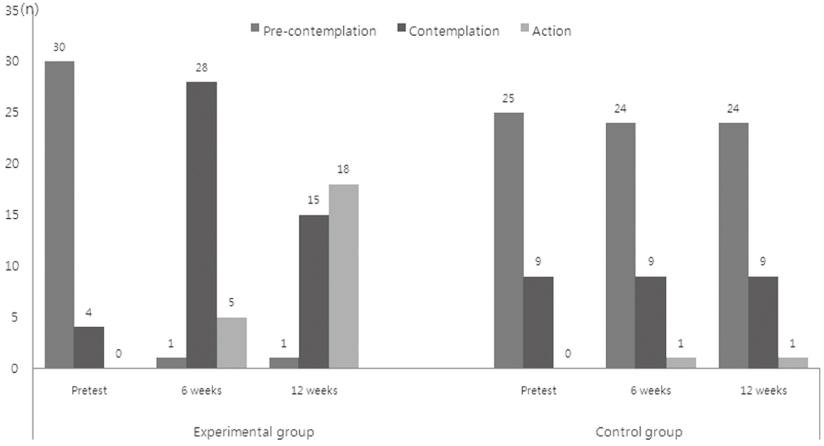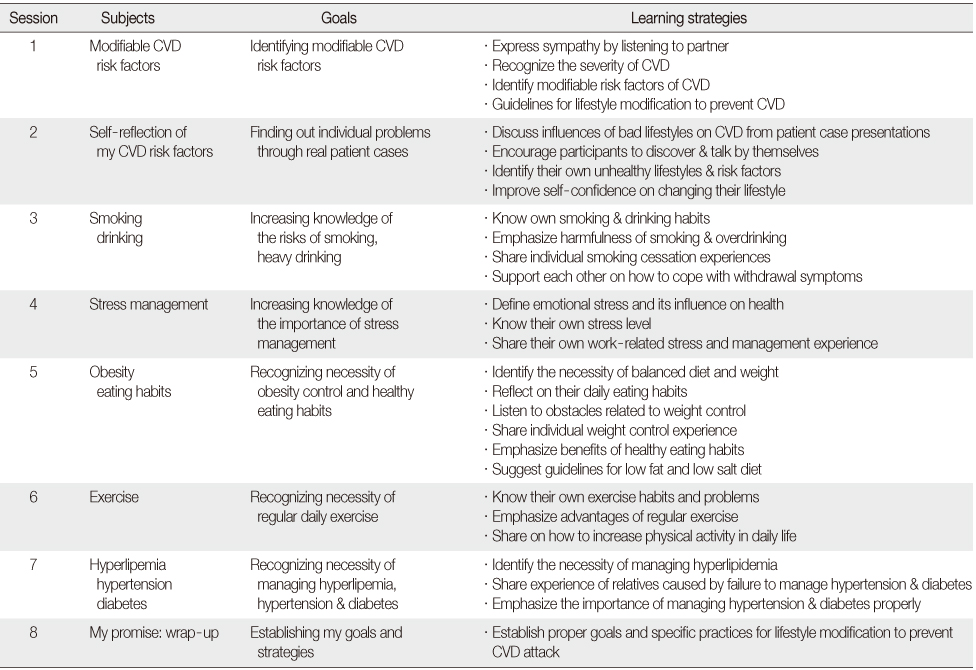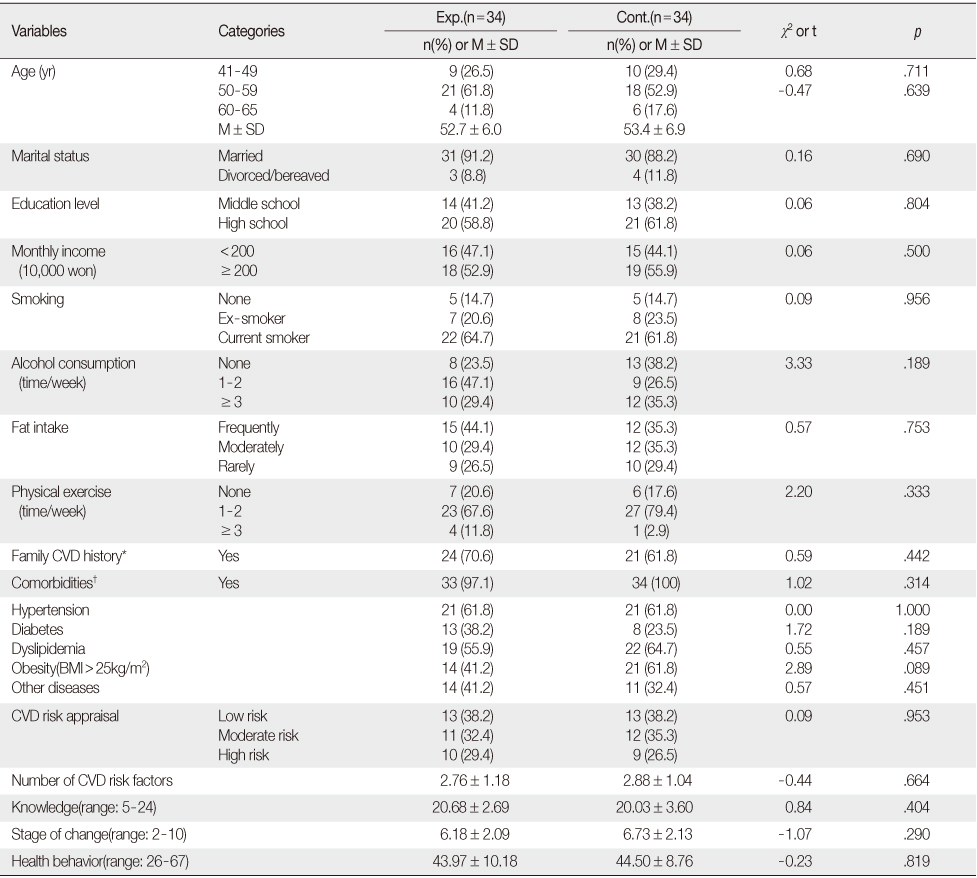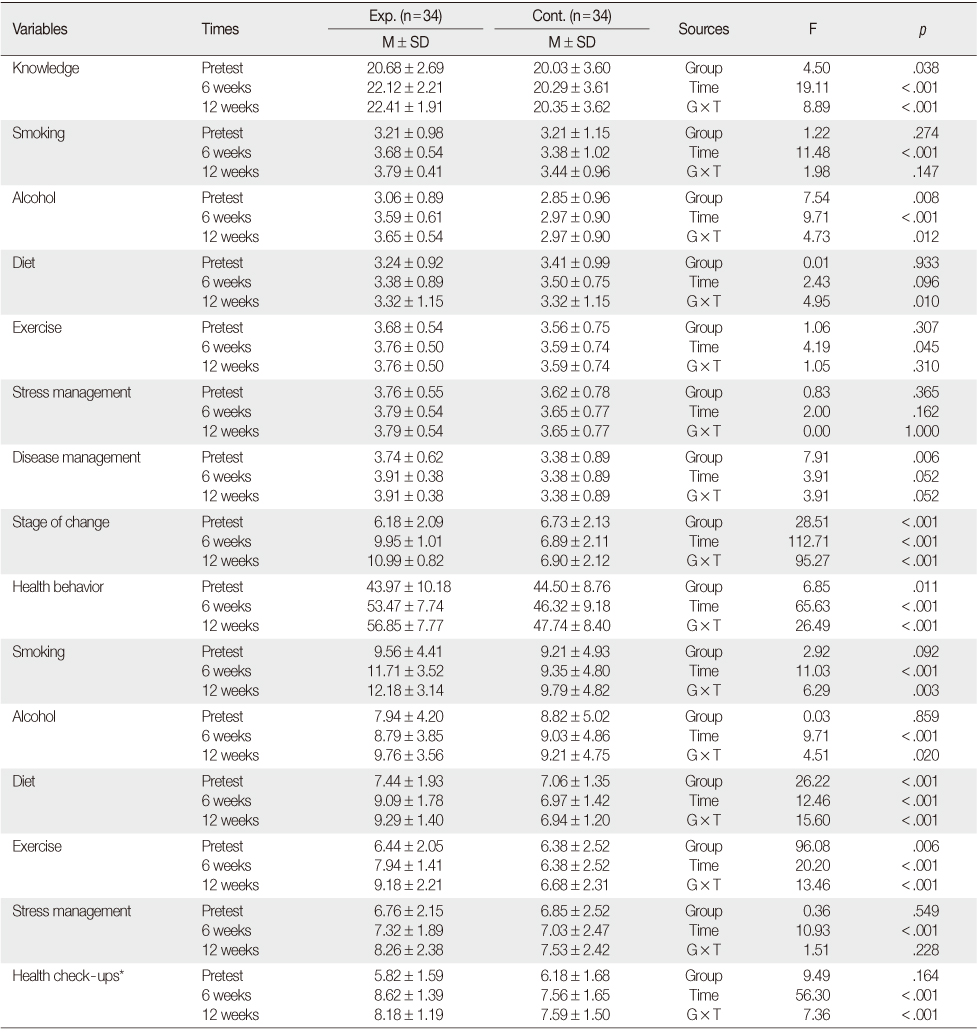Articles
- Page Path
- HOME > J Korean Acad Nurs > Volume 42(3); 2012 > Article
-
Original Article
- Development and Evaluation of a Small Group-based Cardiocerebrovascular Disease Prevention Education Program for Male Bus Drivers
- Eun Young Kim, Seon Young Hwang
-
Journal of Korean Academy of Nursing 2012;42(3):322-332.
DOI: https://doi.org/10.4040/jkan.2012.42.3.322
Published online: June 29, 2012
1Full-time Lecturer, Department of Nursing, Seonam University, Namwon, Korea.
2Assistant Professor, Department of Nursing, Chosun University, Gwangju, Korea.
- Address reprint requests to: Hwang, Seon Young. Department of Nursing, Chosun University, 375 Seosuk-dong, Dongu, Gwangju 501-759, Korea. Tel: +82-62-230-7637, Fax: +82-62-230-6329, seon9772@chosun.ac.kr
© 2012 Korean Society of Nursing Science
- 636 Views
- 3 Download
- 10 Crossref
Abstract
-
Purpose
- This study was conducted to examine effects of a small group-based cardiocerebrovascular disease (CVD) prevention education program on knowledge, stage of change and health behavior among male bus drivers with CVD risk factors.
-
Methods
- A non-equivalent control group pretest-posttest design was used. Participants were 68 male bus drivers recruited from two urban bus companies. Participants from the two groups were selected by matching age, education and risk factors. Experimental group (n=34) received a small group-based CVD prevention education program 8 times over 6 weeks and 3 times through telephone interviews at 2-week intervals. Data were collected between December, 2010 and March, 2011, and were analyzed using chi-square test, t-test, and repeated measure analysis of variance with SPSS/Win18.0.
-
Results
- Experimental group showed significantly higher scores in CVD prevention knowledge (p<.001) and health behavior (p<.001) at 6 and 12 weeks after intervention. Participants in pre-contemplation and contemplation stages made progress to contemplation and action. This was significantly better at 6 and 12 weeks after intervention (p<.001).
-
Conclusion
- Results suggest that small group-based education programs for CVD prevention are effective in increasing knowledge, stage of change, and health behavior to prevent CVD among male bus drivers with CVD risk.
This article was based on a part of the first author's doctoral thesis.
This study was sponsored by Chosun University Research Fund 2010.
- 1. Arao T, Oida Y, Maruyama C, Mutou T, Sawada S, Matsuzuki H, et al. Impact of lifestyle intervention on physical activity and diet of Japanese workers. Preventive Medicine. 2007;45:146–152. http://dx.doi.org/10.1016/j.ypmed.2007.05.004.ArticlePubMed
- 2. Bigert C, Klerdal K, Hammar N, Hallqvist J, Gustavsson P. Time trends in the incidence of myocardial infarction among professional drivers in Stockholm 1977-1996. Occupational and Environmental Medicine. 2004;61:987–991. http://dx.doi.org/10.1136/oem.2004.012781.PubMedPMC
- 3. Bong HC. Action learning for successful study. 2006;Seoul, Dasanseogo.
- 4. Chon SH, Kim JY, Cho JJ, Ryoo JG. Job characteristics and occupational stress on health behavior in Korean workers. Korean Journal of Family Medicine. 2010;31:444–452. http://dx.doi.org/10.4082/kjfm.2010.31.6.444.Article
- 5. DiClemente CC, Carbonari JP, Montgomery RP, Hughes SO. The alcohol abstinence self-efficacy scale. Journal of Studies on Alcohol. 1994;55:141–148.ArticlePubMed
- 6. Haupt CM, Alte D, Dörr M, Robinson DM, Felix SB, John U, et al. The relation of exposure to shift work with atherosclerosis and myocardial infarction in a general population. Atherosclerosis. 2008;201:205–211. http://dx.doi.org/10.1016/j.atherosclerosis.2007.12.059.ArticlePubMed
- 7. Jang CH, Choi YA, Lee HM, Kang YS, Kim CH, Noh SY, et al. A study on the relationship between obesity and life style among cab drivers in Gyeongju. Dongguk Journal of Medicine. 2004;11(2):62–73.
- 8. Jung HS, Jhang WG. An intervention study for hypertension in small scale enterprises based on transtheoretical and ecological model. Korean Journal of Occupational Health Nursing. 2006;15(2):153–164.
- 9. Kang KJ, Song MS. Development and evaluation of motivational enhancement therapy for patients with coronary artery disease. Journal of Korean Clinical Nursing Research. 2010;16(2):5–16.
- 10. Karlsson B, Alfredsson L, Knutsson A, Andersson E, Torén K. Total mortality and cause-specific mortality of Swedish shift- and dayworkers in the pulp and paper industry in 1952-2001. Scandinavia Journal of Work, Environment & Health. 2005;31:30–35. http://dx.doi.org/10.5271/sjweh.845.Article
- 11. Kim EM, Yun SN. The effect of occupational health service for the aged workers in small workplaces. Korean Journal of Occupational Health Nursing. 2010;19(1):78–87.
- 12. Kim EY, Hwang SY. Incidence risk of cardiocerebrovascular disease, preventive knowledge, stage of change and health behavior among male bus drivers. Korean Journal of Adult Nursing. 2011;23:321–330.
- 13. Ko JK. Analysis of factors affecting the health behavior of taxi-drivers. Journal of East-West Nursing Research. 2009;15:71–81.
- 14. Korea Centers for Disease Control and Prevention. Korea health statistics 2009: Korea national health and nutrition examination survey (KNHANESIV-3). 2010;Retrieved May 5, 2011. from http://knhanes.cdc.go.kr.
- 15. Korea Occupational Safety and Health Agency. Prevention education manual of cardiocerebrovascular diseases. 2008;Incheon, Author.
- 16. Korea Occupational Safety and Health Agency. A study on workers' health management activation methods for early prevention of cardiocerebrovascular diseases for the aging society. 2009;Incheon, Author.
- 17. Lee SY, Lee KS, Koo JW, Yim HW, Kim HR, Park CY, et al. Effectiveness of tailored health promotion program for reducing cardiovascular risk factors in subway workers. Korean Journal of Occupational and Environmental Medicine. 2006;18:15–24.ArticlePDF
- 18. Lee YJ. An education program to modify lifestyle: Effects on health behavior and physiological parameters in patients with coronary disease. Clinical Nursing Research. 2007;13(3):43–54.
- 19. Lim KO. Work ability and fatigability of taxi and bus drivers according to health states. 2007;Daegu, Kyungpook National University. Unpublished doctoral dissertation.
- 20. Miller WR. Cho SH Shin SG . Interview for addiction and health motive. 2007;Seoul, Sigmapress. (Original work published 1999).
- 21. Nasri H, Moazenzadeh M. Coronary artery disease risk factors in drivers versus people in other occupations. Arya Atherosclerosis. 2006;2(6):75–78.
- 22. National Heart Lung and Blood Institute. Coronary heart disease risk factors. 2011;Retrieved May, 2011. from http://www.nhlbi.nih.gov/health/health-topics/topics/hd/atrisk.html.
- 23. Panagiotakos DB, Kromhout D, Menotti A, Chrysohoou C, Dontas A, Pitsavos C, et al. The relation between pulse pressure and cardiovascular mortality in 12,763 middle-aged men from various parts of the world: A 25-year follow-up of the seven countries study. Archives of Internal Medicine. 2005;165:2142–2147. http://dx.doi.org/10.1001/archinte.165.18.2142.PubMed
- 24. Park HJ. The effects of lifestyle modification education program on the workers' knowledge, attitude and behavior to prevent cerebrocardiovascular diseases in middle and small-sized industries. 2008;Seoul, Dongguk University. Unpublished master's thesis.
- 25. Pettman TL, Misan GM, Owen K, Warren K, Coates AM, Buckley JD, et al. Self-management for obesity and cardio-metabolic fitness: Description and evaluation of the lifestyle modification program of a randomized controlled trial. The International Journal of Behavioral Nutrition and Physical Activity. 2008;5:53. http://dx.doi.org/10.1186/1479-5868-5-53.PubMedPMC
- 26. Poo WJ. The development and evaluation of health promotion program for bus drivers. 2007;Seoul, Seoul National University. Unpublished master's thesis.
- 27. Sol BG, van der Graaf Y, van der Bijl JJ, Goessens BM, Visseren FL. The role of self-efficacy in vascular risk factor management: A randomized controlled trial. Patient Education and Counseling. 2008;71:191–197. http://dx.doi.org/10.1016/j.pec.2007.12.005.ArticlePubMed
- 28. Statistics Korea. 2009 Annual report of causes of deaths. 2009;Daejeon, Author.
- 29. Stirrat C, Mann S. Perceptions of cardiovascular risk factors among cardiology outpatients. Heart, Lung & Circulation. 2008;17S:S22–S23. http://dx.doi.org/10.1016/j.hlc.2008.03.051.
- 30. World Health Organization. Prevention of cardiovascular disease(2007). 2007;Geneva, Author.
REFERENCES


This criteria is based on the appraisal of the risk for CVD suggested by Korea Occupational Safety and Health Agency (2009).
SBP=Systolic blood pressure; DBP=Diastolic blood pressure; BMI=Body mass index.
*This study adopted an overweight criteria=BMI 25 kg/m2 not=BMI 30 kg/m2 according to WHO definition for active prevention; †For stroke only.
Figure & Data
REFERENCES
Citations

- Effects of a Health Partnership Program Using Mobile Health Application for Male Workers with Cardiovascular Risk Factors in Small and Medium Enterprises: A Randomized Controlled Trial
Eun Jin Kim, Seon Young Hwang
Journal of Korean Academy of Nursing.2024; 54(1): 44. CrossRef - Associations of depression and anxiety with cardiovascular risk among people living with HIV/AIDS in Korea
Kyong Sil Park, Seon Young Hwang, Bo Youl Choi, June Kim, Sang Il Kim, Woo-Joo Kim, Chun Kang
Epidemiology and Health.2020; 43: e2021002. CrossRef - Effects of Spouse-Participated Health Coaching for Male Office Workers with Cardiocerebrovascular Risk Factors
So Hee Kang, Seon Young Hwang
Journal of Korean Academy of Nursing.2019; 49(6): 748. CrossRef - Risk Factor–tailored Small Group Education for Patients with First-time Acute Coronary Syndrome
Seon Young Hwang, Jin Shil Kim
Asian Nursing Research.2015; 9(4): 291. CrossRef - Effects of a Cardiocerebrovascular Disease Prevention Education Program for Postmenopausal Middle-aged Women
Soo Kyung Choi, In Sook Kim
Journal of Korean Academy of Nursing.2015; 45(1): 25. CrossRef - The Effects of Individual Counseling for Bus-drivers to Cerebrovascular and Cardiovascular Disease Prevention: Secondary Data Analysis
Hye-Sun Jung, Mi-Jung Eum, Insun Jang
Korean Journal of Occupational Health Nursing.2015; 24(4): 281. CrossRef - Ecological Correlates of Cardiovascular Disease Risk in Korean Blue-collar Workers: A Multi-level Study
Won Ju Hwang, Yunhee Park
Journal of Korean Academy of Nursing.2015; 45(6): 857. CrossRef - Knowledge on Cardiovascular Prevention and Nicotine Dependency among Smoking Male College Students
Seon Young Hwang, Kyongok Park
Journal of Korean Academy of Community Health Nursing.2014; 25(2): 75. CrossRef - Effects of a Comprehensive Lifestyle Improvement Program for Middle-aged Women with Cardio-cerebrovascular Disease-related Risk Factors
Mi-Kyoung Park, Jeong-Hee Kim
Journal of Korean Academy of Community Health Nursing.2013; 24(2): 111. CrossRef - Development and Evaluation of Cardiocerebrovascular Disease Prevention Program for Taxi Drivers
Mi-Yang Jeon, Youngl-SU Song, Hyung-Tae Jung, Jung-Sok Park, Hye-Young Yoon, Eliza Lee
Journal of the Korea Academia-Industrial cooperation Society.2013; 14(9): 4437. CrossRef

Figure 1
Participants' Appraisal of the Risk for Cardiocerebrovascular Disease (CVD)
This criteria is based on the appraisal of the risk for CVD suggested by Korea Occupational Safety and Health Agency (2009).
SBP=Systolic blood pressure; DBP=Diastolic blood pressure; BMI=Body mass index.
*This study adopted an overweight criteria=BMI 25 kg/m2 not=BMI 30 kg/m2 according to WHO definition for active prevention; †For stroke only.
Learning Goals and Strategies of the CVD Prevention Educational Program
CVD=Cardiocerebrovascular diseases.
Homogeneity Test of Characteristics and Dependent Variables (N=68)
Exp.=Experimental group; Cont.=Control group.
*Includes at least one case of hypertension, diabetes, angina, myocardial infarction, or stroke; †Answers were duplicated.
CVD=Cardiocerebrovascular disease; BMI=Body mass index.
Comparison of Dependent Variables between Two Groups across Three Different Time Periods (N=68)
*Includes check-ups for blood pressure, blood sugar and body weight.
Exp.=Experimental group; Cont.=Control group; G×T=group×time.
This criteria is based on the appraisal of the risk for CVD suggested by Korea Occupational Safety and Health Agency (2009). SBP=Systolic blood pressure; DBP=Diastolic blood pressure; BMI=Body mass index. *This study adopted an overweight criteria=BMI 25 kg/m2 not=BMI 30 kg/m2 according to WHO definition for active prevention; †For stroke only.
CVD=Cardiocerebrovascular diseases.
Exp.=Experimental group; Cont.=Control group. *Includes at least one case of hypertension, diabetes, angina, myocardial infarction, or stroke; †Answers were duplicated. CVD=Cardiocerebrovascular disease; BMI=Body mass index.
*Includes check-ups for blood pressure, blood sugar and body weight. Exp.=Experimental group; Cont.=Control group; G×T=group×time.
 KSNS
KSNS
 E-SUBMISSION
E-SUBMISSION



 Cite
Cite

